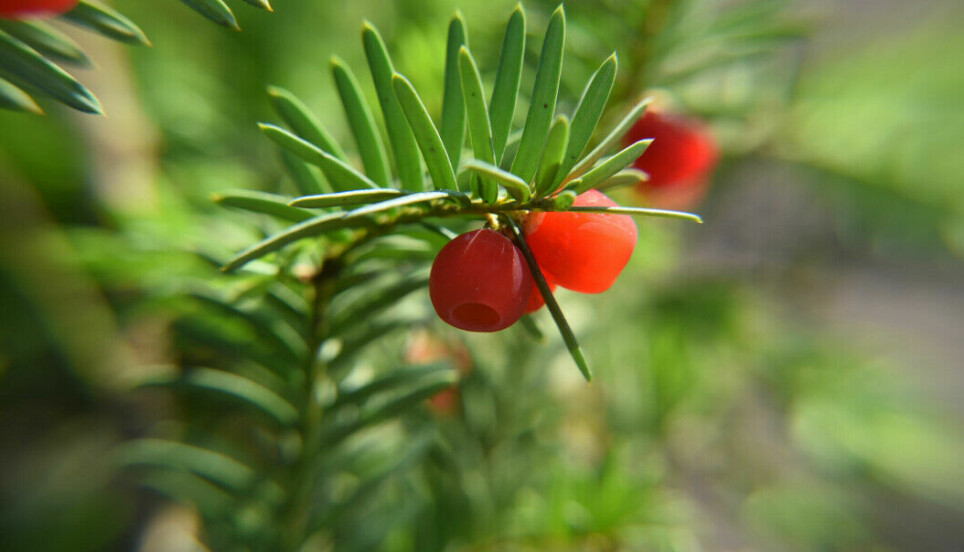
This is how forensic toxicologists revealed yew as the cause of a mysterious death
In order to determine the cause of death, they collected twigs and bark from their own gardens.
Yew is an evergreen tree with needle leaves that resembles a bush. It is native to southern Norway, but is also popular as potted plants, ornamental shrubs, and hedges in Norwegian gardens.
However, yew is poisonous.
A healthy person was suddenly found unconscious and with symptoms of acute heart failure. A few hours before this, the person was physically fine. Now suddenly, the person was dead.
The circumstances around the death, and the fact that it happened so fast, led the forensic pathologist on call to suspect poisoning.
Finding out what kind of poison caused the patient’s death, however, took a good deal of detective work. The forensic toxicologists who found the cause of death explain how they arrived at their conclusion in a comment published by the Journal of the Norwegian Medical Association (link in Norwegian).
The first analysis yielded no results
The regular screening yielded no results.
The forensic toxicologists used a method that makes it possible to separate all the different substances present in blood from each other. They could then compare these substances from the victim’s blood against 850 known substances.
These are mostly drugs and medicines, as well as some more unusual substances, according to Merete Vevelstad, Senior medical officer at the Department of Forensic Medicine at Oslo University Hospital.

“All laboratories have to choose which substances to include in a method, since it would be too resource-intensive to compare against everything in all cases,” the forensic toxicologist writes in an e-mail to sciencenorway.no.
On the right track
Now the toxicologists had to expand the search.
They compared the content of the blood with a larger variety of substances. This time, 3,000 different substances were included. The search yielded a hit.
A substance called 3,5-dimethoxyphenol was found in the blood of the deceased.
The substance itself is not toxic, but is found in yew. It is, however, also found in a few other plants.
The doctors were on the right track, but still not quite there.
"Would normally have been overlooked"
In order to arrive at a more final answer, the forensic toxicologists obtained yew from their own gardens. The toxins in yew, taxines, are not available off the shelf.
They separated the toxins from bark, needles and twigs they had collected themselves.
Finally they reached their conclusion. By comparing the toxins from these yew samples with the analysis of the blood of the deceased, they got the answer: Taxines were found in the blood.
The poison must have originated from either a yew tree or a yew extract.
“A cause of death that normally would have been overlooked, was now revealed,” the forensic toxicologists explain in the Journal of the Norwegian Medical Association.
Lily of the valley, fox bell and yew
In 2021, the Norwegian Poison Information Centre received 3,638 reports about possible poisoning from plants. Most of these incidents turned out to be harmless.
In the Norwegian Poison Information Centre’s annual report from 2021 (link in Norwegian), three plants repeatedly had the most serious outcomes:
Lily of the valley, fox bell and yew.
Developing new methods for plant and mushroom toxins
The entire yew plant, except for the red pulp of the berries, contain toxins. In order to ingest a lethal amount however, you have to eat quite a bit.
Most of the known cases in newer times have been suicides, the forensic toxicologists write in their comment. They also point out the fact that people can buy very toxic plants today, without them being branded as such in any way.
Oslo University Hospital is currently increasing their competencies on poisoning by plants and mushroom toxins with a newly established group of experts.
“The group is developing a new and advanced method of analysis as well as a database with the most relevant plant- and mushroom toxins. The method will give us better diagnostics and knowledge about such poisonings in Norway”, Vevelstad writes to sciencenorway.no.
------
Read the Norwegian version of this article on forskning.no
































